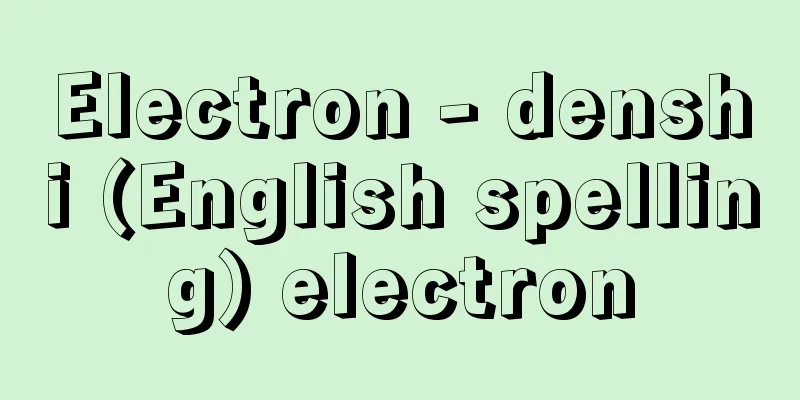Electron - denshi (English spelling) electron

|
A type of elementary particle. Symbolized as e or e - . It is a stable particle with a mass about 1/1800th of that of a proton (the nucleus of the hydrogen atom), with a negative charge equal to and opposite to that of a proton, and has not been observed to decay into other particles. It is an important component of atoms that make up matter. At the center of a neutral atom is a very small nucleus that accounts for most of the atom's mass, and around it move electrons, the number of which is equal to the atomic number, enough to cancel out the positive charge of the nucleus. This picture of the atom was established by Rutherford's discovery of the atomic nucleus and the subsequent establishment of quantum mechanics in the 1910s and 1920s. However, it was not until the end of the 19th century that the existence of the electron as a new entity different from known particles was established, through research into various phenomena involving electrons. Many modern cutting-edge technologies apply the properties of electrons. [Kanji Fujii] Origin of the name ElectronThere are ancient records of the phenomenon where two suitable objects become electrically charged when rubbed against each other. In English, electron is called "electron," and this word originates from the Greek word for amber. Since amber becomes electrically charged due to friction, the term came to mean something that is produced by friction, or electricity. This phenomenon of charging occurs when the distribution of electric charge changes between two objects that come into contact with each other, in other words, the electrons are rearranged. Friction is simply a means of rearranging the electrons, which are easily mobile within a substance. [Kanji Fujii] Discovery of the ElectronThe existence of electrons was established based on research into cathode rays in vacuum discharges. Faraday began his research into vacuum discharges in 1836, and then in the mid-19th century, German physicist and mathematician Plucker began full-scale research using a discharge tube that he had invented and asked engineer Geissler to build. Plucker discovered that the glass wall close to the cathode emitted fluorescence, and thought that this was caused by a type of radiation emanating from the cathode. He also discovered that this radiation could be bent by the action of a magnet. Much research was carried out into the nature of cathode rays, and it was not until the end of the 19th century, with the contributions of J. J. Thomson and H. A. Lorentz, that it was determined that they were a flow of previously unknown particles called electrons. Thomson determined the speed of cathode rays using a rotating mirror and showed that it was less than one-hundredth of the speed of electromagnetic waves (light), thus denying the theory that cathode rays are vibrations of the ether (the medium of electromagnetic waves) (1894). The following year, Perrin captured cathode rays in a metal box and showed that the box was negatively charged. Thomson assumed that cathode rays were made up of negatively charged particles, and measured the specific charge of the particles e / m e (where e is the absolute value of the particle's charge and m e is its mass) under various conditions (such as changing the material of the cathode that emits the particles and the gas inside the cathode ray tube), obtaining a value about 1,000 times larger than the specific charge of a hydrogen ion. He then measured the charge e itself and showed that it was almost the same magnitude as the charge of a hydrogen ion. Thus, it was discovered that cathode ray particles are of one type, regardless of the material of the cathode that emits them, and have a mass much smaller than that of an atom. On the other hand, Zeeman discovered (1896) that when a sodium flame is placed between a magnetic field, the D line of the spectrum broadens. Lorentz gave the following explanation: There are light ions inside an atom, which undergo periodic motion according to the laws of force governing the atom, and emit light with the frequency of the periodic motion. When an external magnetic field is applied to this, the light ions experience the same kind of force as cathode ray particles, changing the frequency of their motion. As a result, the spectral lines of the light emitted from the atom are separated. Lorentz showed that an additional frequency is added that is shifted by an amount proportional to the product of the specific charge e i / m i of the light ion ( e i is the absolute value of the charge of the light ion, and m i is its mass) and the magnitude of the external magnetic field. Zeeman determined the specific charge experimentally according to this. Lorentz then calculated e i 2 / m i from his theory of the refractive index of light, and combined it with Zeeman's measurements to determine e i and m i separately, and showed that these values were almost identical to those obtained by Thomson. Thus, the existence of electrons was revealed as a new entity within atoms that, although it accounts for only a small portion of the atom's mass, plays an important role in determining the emission of light from atoms and the chemical and physical properties of elements. [Kanji Fujii] Radioactivity and beta raysIn 1896, Becquerel discovered radioactivity as a phenomenon in which uranium compounds emit radiation without external excitation. Later, he confirmed that beta rays, which have a relatively large penetrating electric charge among radiation, are the same as cathode ray particles (1900). These electrons (or their antiparticles, positrons) are not electrons bound to the nucleus and move within the atom, but are involved in the transformation of neutrons and protons that make up the nucleus (for example, neutron → proton + electron + neutrino). Before the discovery of the neutron in 1932, it was thought that the atomic nucleus was in a state of bond between protons and electrons, and that these electrons were emitted as beta rays, but this was in decisive contradiction with experimental facts. [Kanji Fujii] Properties of ElectronsIn 1928, Dirac gave the relativistic wave equation that electrons obey, and predicted the existence of the positron, an antiparticle of the electron, which was confirmed four years later by the particle tracks of cosmic rays. According to this theory, an electron has an intrinsic angular momentum of ħ/2 (ħ = h /2π, where h is the Planck constant) and a magnetic moment of e ħ/(2 m e ) (called the Bohr magneton or Bohr magneton, written as μ B ). However, the experimental value of the latter is slightly off. This deviation, i.e., the anomalous magnetic moment, is understood to be due to the quantum mechanical effect of electrons being surrounded by a cloud of photons, and is in excellent agreement with the calculation results according to quantum electrodynamics. In this calculation, the electron is considered to be a point particle with no extension, so the good agreement between theory and experiment indicates that the electron can only have a very small extension (10 -16 cm) compared to its Compton wavelength. This fact is in stark contrast to the fact that the proton, for example, has a Compton wavelength of ≃2.1× 10-14 cm and a large anomalous magnetic moment of the nuclear magneton eħ /( 2m p ), where m p is the mass of the proton, ≃1.79. Although electric charges smaller than those of electrons and protons have not been directly observed, it has been theoretically shown that the basic entities (quarks) that make up protons and other elements have a smaller electric charge of e /3, and this was confirmed experimentally by the end of the 20th century. It is believed that in the future, research into high-energy elementary particle reactions will raise questions about the structure of the electron and provide new knowledge about the elementary nature of electric charge. [Kanji Fujii] "The Discovery of the Electron and the Atomic Nucleus: The People Who Built 20th Century Physics" by Steven Weinberg, translated by Homma Saburo (1986, Nikkei Science Publishing)" ▽ "Physics One Point 29: Atoms and Atomic Nuclei" by Ogawa Iwao (1990, Kyoritsu Shuppan)" ▽ "Popular Science: How 20th Century Physics Began" by Nishio Shigeko (1997, Shokabo Publishing)" ▽ "Popular Science: The Circulation of Electrons - Cutting-Edge Electronics and Its Pioneers" by Kishino Seigo (1998, Shokabo Publishing)" ▽ "The World of the Atomic Nucleus" by Kikuchi Masashi (Iwanami Shinsho)" [Reference] | | |Source: Shogakukan Encyclopedia Nipponica About Encyclopedia Nipponica Information | Legend |
|
素粒子の一種。eまたはe-の記号を用いる。陽子(=プロトン。水素の原子核)の約1800分の1の質量で、陽子の電荷と大きさが等しく逆符号の負電荷をもち、他の粒子への崩壊が観測されていない安定な粒子であり、物質を構成する原子の重要な構成要素になっている。中性の原子の中心には、原子の質量のほとんどを担った非常に小さな大きさの原子核が存在し、その周りを、核の正電荷を打ち消すだけの、原子番号に等しい個数の電子が運動している。このような原子の描像が確立したのは、ラザフォードによる原子核の発見と、それに引き続いた1910年代から1920年代へかけての量子力学の成立によっている。しかし既知の粒子とは異なる新しい実体として電子の存在が確立したのは、19世紀の末であり、電子が関与するさまざまな現象の研究を通じてこれがなされた。現代の先端技術は、電子の性質を応用したものが多い。 [藤井寛治] エレクトロンという名称の由来適当な2物体を互いに摩擦すると、それらが帯電する現象は、古い記録にも残されている。英語で電子をエレクトロンといい、この単語はギリシア語源でこはくを意味している。こはくが摩擦により帯電することから、摩擦により生じるもの、電気を意味するものになった。このような帯電現象は、互いに触れ合った2物体の間で電荷の分布が変わる、いいかえれば電子の再配置がなされるために生じる。摩擦は、物質中を動きやすい電子を再配置させるための単なる手段にすぎないのである。 [藤井寛治] 電子の発見電子の存在は、真空放電での陰極線の研究を軸にして確立された。1836年にファラデーが真空放電の研究を始め、その後19世紀の中ごろ、ドイツの物理・数学者プリュッカーが、自分で考案して技師ガイスラーに頼んでつくった放電管を用いて本格的研究を始めた。プリュッカーは、陰極に近いガラス壁が蛍光を放つことを発見し、それを一種の放射線が陰極から出ているために生じると考え、その放射線が磁石の作用で曲げられることもみつけた。この陰極線の本性をめぐって多くの研究がなされ、19世紀末にようやく、J・J・トムソンやH・A・ローレンツらの寄与により、電子というそれまで知られていなかった粒子の流れであることが確定した。 トムソンは、回転鏡を用いて陰極線の速さを決め、それが電磁波(光)の伝わる速さの100分の1以下であることを示し、陰極線がエーテル(電磁波の媒体)の振動であるという説を否定した(1894)。翌年ペランは陰極線を金属箱にとらえ、箱が負に帯電することを示した。トムソンは、陰極線が負の電荷をもつ粒子からなると仮定して、粒子の比電荷e/me(ここでeは粒子の電荷の絶対値、meはその質量)を、いろいろな条件(粒子を放出する陰極の物質や陰極線管のなかの気体を変えるなど)のもとで測定したところ、水素イオンの比電荷の約1000倍もの大きな値が得られた。その後、電荷eそのものを測定し、水素イオンの電荷とほぼ同じ大きさであることを示した。こうして、陰極線の粒子は、それを放出する陰極の物質によらず1種類で、原子よりはるかに小さな質量をもつことがわかった。 一方、ナトリウム炎を磁場の間に置くと、スペクトルのD線が広がることをゼーマンが発見した(1896)。ローレンツは次のような説明を与えた。原子内に軽いイオンがあり、原子内を支配する力の法則に従って周期運動をしており、その振動数をもつ光を放出する。ここに外部から磁場が加えられると、陰極線粒子が受けるのと同種の力を軽いイオンが受けて運動の振動数が変わる。その結果、原子から放出される光のスペクトル線が分離する。ローレンツは、軽いイオンの比電荷ei/mi(eiは軽いイオンの電荷の絶対値、miはその質量)と外からかけた磁場の大きさとの積に比例した量だけずれた振動数がさらに加わることを示した。ゼーマンはこれに従って比電荷を実験から決めた。その後ローレンツは、光の屈折率に関する自分の理論からei2/miを求め、ゼーマンの測定値と組み合わせてeiとmiを別々に決め、これらの数値がトムソンの得た値とほぼ一致することを示した。こうして、原子内にあって、その質量の小さな部分を占めるにすぎないけれども、原子からの光の放出や、元素の化学的・物理的性質を決めるうえで重要な役割を果たす新しい実体としての電子の存在が明らかになった。 [藤井寛治] 放射能とβ線1896年ベックレルは、ウラン化合物が外からの励起なしに放射線を出す現象として放射能を発見した。その後、彼は、放射線のなかで比較的透過力の大きい電荷をもつβ(ベータ)線が、陰極線粒子と同じものであることを確証した(1900)。この電子(またはその反粒子の陽電子)は、原子核に束縛されて原子内を運動する電子ではなく、核を構成する中性子や陽子が転化する際に伴うものである(たとえば、中性子→陽子+電子+中性微子(ニュートリノ))。1932年に中性子が発見される以前には、原子核が陽子と電子の結合状態であり、その電子がβ線として放出されると考えられたが、実験事実との決定的な矛盾が生じていた。 [藤井寛治] 電子の性質1928年ディラックは、電子が従う相対論的波動方程式を与え、電子の反粒子である陽電子(ポジトロン)の存在を予言し、4年後に宇宙線の粒子軌跡から確認された。この理論によれば、電子は固有の角運動量ħ/2(ħ=h/2π、hはプランク定数)、磁気モーメントの大きさeħ/(2me)(これをボーア磁子またはボーア・マグネトンとよび、μBと書く)をもつことになる。ところが後者の実験値は、わずかにずれている。このずれ、すなわち異常磁気モーメントは、電子が光子(フォトン)の雲を周りに着るという量子力学的な効果によるものと理解されており、量子電磁力学に従った計算結果と非常によい一致が得られている。この計算では、電子は広がりをもたない点粒子とみなされているので、理論と実験のよい一致は、電子がそのコンプトン波長に比べて非常に小さい広がり(10-16cm)しかもちえないことを示している。この事実は、たとえば陽子は、コンプトン波長≃2.1×10-14cm程度の広がりと、異常磁気モーメントが核磁子(核マグネトン)eħ/(2mp)単位で(mpは陽子の質量)≃1.79という大きな値をもつことときわめて対照的である。電子や陽子の電荷の大きさよりも小さな電気量は直接に観測されていないが、陽子などを構成する基本的な実体(クォーク)がより小さなe/3単位の電荷をもつことが理論的に示され、20世紀末までにそれが実験からも確かめられた。将来、高エネルギーの素粒子反応の研究によって電子の構造が問題になり、電荷の素量性についての新しい知識も得られるであろうと考えられている。 [藤井寛治] 『スティーブン・ワインバーグ著、本間三郎訳『電子と原子核の発見 20世紀物理学を築いた人々』(1986・日経サイエンス社)』▽『小川岩雄著『物理学One Point29 原子と原子核』(1990・共立出版)』▽『西尾成子著『ポピュラー・サイエンス こうして始まった20世紀の物理学』(1997・裳華房)』▽『岸野正剛著『ポピュラー・サイエンス 電子はめぐる――先端エレクトロニクスとその開拓者たち』(1998・裳華房)』▽『菊池正士著『原子核の世界』(岩波新書)』 [参照項目] | | |出典 小学館 日本大百科全書(ニッポニカ)日本大百科全書(ニッポニカ)について 情報 | 凡例 |
<<: Electronic Organ - Denshi Organ
Recommend
Tropolone - tropolone
It is one of the representative seven-membered ri...
D'Entrecasteaux [Islands] - D'Entrecasteaux
Volcanic islands distributed around the southeaste...
Kyoto School
A general term for a group of philosophers from th...
Chóng Lí (English spelling)
A god who appears in the Chinese creation tale. In...
Baikanamako - Baikanamako
A marine animal belonging to the phylum Echinoder...
Wangjian City - Wangjian City
...the name of an ancient Korean dynasty. One of ...
Creel
Also written as "fish basket." A contain...
Friedrich Kayssler
1874‐1945 He was one of the leading actors in the ...
United Nations University (English name) United Nations University
A research and training institute operated under ...
Hozumi [town] - Hozumi
A former town in Motosu County in the southwest of...
Blue Wolf
A historical novel by Yasushi Inoue. It depicts th...
Irregular shaped bricks
...The most common example is shown in the figure...
Doll Pass - Ningyo Touge
A pass on the border between Misasa Town, Tohaku ...
Afonso Henriques
…reigned 1139-85. Also called Afonso Henriques. B...
Death from electrocution
Death by electric shock. A type of shock death cau...









